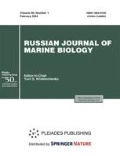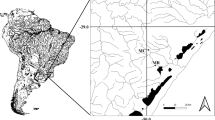Abstract
Data on the biology of the Japanese swimming crab, such as sexual dimorphism, size and weight structure, sex ratio, allometric growth, and fecundity were obtained in Sukhodol Bay (Ussuri Bay). The maximum carapace width was 116 mm and the largest weight was 340 g in males and 107 mm and 210 g, respectively, in females. The female to male ratio was 1.0: 2.4. The mean number of eggs in a clutch was 571300 (94000–1786000). Molting lasted from August through October, and a mass molt was recorded in August. As compared to crabs of the central part of the range, off the Korean Peninsula, Charybdis japonica in Ussuri Bay had larger size and higher fecundity. The breeding period in Ussuri Bay was slightly shifted from June–August to late June-September. The mass hatching of larvae occurred in July.
Similar content being viewed by others
References
Vasilenko, S.V., The Japanese Swimming Crab Charybdis japonica, Krasnaya kniga Rossiiskoi Federatsii (Red Data Book of the Russian Federation), 1997, http://www.biodat.ru.
Vinogradov, L.G., The Field Guide to Shrimps, Crawfish, and Crabs of Far East, Izv. TINRO, 1950, vol. 33, pp. 179–356.
Grigoryeva, N.I., Spatial Distribution of Crab Larvae (Decapoda: Anomura et Brachyura) in Posyet Bay (Peter the Great Bay, Sea of Japan), Okeanologiya, 2009, vol. 49, no. 5, pp. 715–724.
Zhivotnye i rasteniya zaliva Petra Velikogo (Animals and Plants of Peter the Great Bay), Leningrad: Nauka, 1976.
Zadorozhny, P.A., Borisovets, E.E., Yakush, E.V., and Davidyuk, T.S., Changes in Composition of Carotinoids in Crabs during Embryogenesis, Zh. Evol. Biokh. Fiziol., 2008, vol. 44, no. 4, pp. 381–390.
Kolpakov, E.V. and Kolpakov, N.V., Population Size-Age Structure and Growth of the Subtropical Bivalve Nuttallia obscurata in Primorye Waters at the North Boundary of Its Geographic Range, Russ. J. Mar. Biol., 2005, vol. 31, no. 3, pp. 190–193.
Krechmar, A.V., Ranges of Northern Birds, Priroda, 2010, no. 9, pp. 56–63.
Lutaenko, K.A., On the Origin of Warm-Water Elements of Malacofauna of Peter the Great Bay, Sea of Japan, Biologiya Morya, 1991, no. 1, pp. 12–20.
Lutayenko, K.A., Mollusk Shells in Holocene Deposits on the Coast of the Ussuri Bay Apex, Sea of Japan, Biologiya Morya, 1988, no. 6, pp. 65–67.
Nizyaev, S.A., Bukin, S.D., Klitin, A.K., et al., Posobiye po izucheniyu promyslovykh rakoobraznykh dal’nevostochnykh morei Rossii (The Handbook of the Study of Commercial Crustaceans in Far Eastern Seas of Russia), Yuzhno-Sakhalinsk: SakhNIRO, 2006.
Nikitin, A.A. and Dyakov, B.S., The Structure of Fronts and Gyres in the Western Sea of Japan, Izv. TINRO, 1998, vol. 124, pp. 714–733.
Olifirenko, A.B., Features of Biology of the Bivalve Anadara broughtoni in Peter the Great Bay, Sea of Japan, Extended Abstract of Cand. Sci. (Biol.) Dissertation, Vladivostok: TINRO-Tsentr, 2007.
Semen’kova, E.G., Biology and Prospects of Fishing for the Japanese Mitten Crab Eriocheir japonica in Water Bodies of Primorsky Krai, Extended Abstract of Cand. Sci. (Biol.) Dissertation, Vladivostok: TINRO-Tsentr, 2007.
Slizkin, A.G. and Safronov, S.G., Promyslovye kraby prikamchatskikh vod (Commercial Crabs of Kamchatkan Coastal Waters), Petropavlovsk-Kamchatsky: Severnaya Patsifika, 2000.
Sokolovsky, A.S. and Sokolovskaya, T.G., Climate, Fishery, and the Dynamics of Ichthyofauna Diversity in Peter the Great Bay on the Century Profile, Vestn. DVO RAN, 2005, no. 1, pp. 43–50.
Barabanshchikov, E.I., Kolpakov, N.V., and Nazarov, V.A., Invasion of Non-Indigenous Animal Species into the Russian Far East Marine and Estuarine Ecosystems, Program Abstracts of PICES XV Annual Meeting, Yokohama, Japan, 2006, p. 91.
Browne, G. and Jones, E., Review of Methods for the Control of the Invasive Swimming Crab Charybdis japonica in New Zealand, Res. Report, Kingett Mitchell Limited, 2006.
Derjugin, K.M. and Kobjakowa, S., Zur Dekapodenfauna des Japanischen Meeres, Zool. Anz., 1935, vol. 112(5/6), pp. 141–147.
Dunham, P.J., Sex Pheromones in Crustacean, Biol. Rev., 1978, vol. 53, pp. 555–583.
Grigoryeva, N.I., Seasonal Dynamics of the Crab Larvae in Minonosok Inlet (Posyet Bay, Peter the Great Bay, The Sea of Japan) in 2000–2004, Proc. China-Russia Bilateral Symposium on “Comparison on Marine Biodiversity in the Northwest Pacific Ocean”, Qingdao, China, 2010, pp. 155–164.
Jiang, W., Meng, T., Chen, R., and Wei, S., Diet of Charybdis japonica (A. Milne-Edwards) and Portunus trituberculatus (Miers) in the Bohai Sea, Mar. Fish. Res. (Shandong), 1998, vol. 19(1), pp. 53–59.
Kim, K.B., Growth and Reproduction of Charybdis japonica (A. Milne-Edwards) (De-capoda: Portunidae) in Korean Waters, Ph.D. Thesis, Department of Marine Biology, Graduate School, Pukyong National University, Pusan, 2001. (In Korean.)
Lutaenko, K.A., Climatic Optimum During the Holocene and the Distribution of Warm-Water Mollusks in the Sea of Japan, Palaeogeography, Palaeoclimatology, Palaeoecology, 1993, vol. 102, no. 3–4, pp. 273–281.
Miller, A., Inglis, G.J., and Poulin, R., Comparison of the Ectosymbionts and Parasites of an Introduced Crab, Charybdis japonica, with Sympatric and Allopatric Populations of a Native New Zealand Crab, Ovalipes catharus (Brachyura: Portunidae), New Zealand J. Mar. Fresh. Res., 2006, vol. 40, pp. 369–378.
Smith, P.J., Webber, W.R., McVeagh, S.M., et al., DNA and Morphological Identification of an Invasive Swimming Crab Charybdis japonica (A. Milne-Edwards, 1891) in New Zealand Waters, New Zealand J. Mar. Fresh. Res., 2003, vol. 37, pp. 753–762.
Wang, C., Xue, L., Liu, F., and Pan, J., The Preliminary Study on Reproductive Biology of Charybdis japonica (A. Milne-Edwards), J. Zhejiang Coll. Fish., 1996, vol. 15, pp. 261–266.
Webber, R., Space Invaders: Crabs That Turn up in New Zealand Unannounced, Seafood New Zealand, 2001, November, pp. 80–84.
Ye, S., Zhang, Z., and Ye, Q., The Biological Characteristics of Charybdis japonica in Southern Fujian, J. Fujian Fish., 2002, vol. 4, pp. 18–21.
Author information
Authors and Affiliations
Corresponding author
Additional information
Original Russian Text © N.V. Kolpakov, E.V. Kolpakov, 2011, published in Izvestiya TINRO.
Rights and permissions
About this article
Cite this article
Kolpakov, N.V., Kolpakov, E.V. On the biology of the Japanese swimming crab Charybdis japonica (Portunidae) in waters of primorye at the northern boundary of their range. Russ J Mar Biol 37, 570–578 (2011). https://doi.org/10.1134/S1063074011070042
Received:
Published:
Issue Date:
DOI: https://doi.org/10.1134/S1063074011070042




